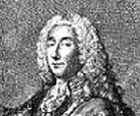LOUIS DE MAILLY
Louis de Mailly (1657-1724), also known as Chevalier de Mailly, was a French man of letters and an illegitimate scion of the noble Mailly family. He had good relations with the French court and aristocratic circles. He embarked upon a literary career and started writing ‘contes’ (‘tales’), and gallant novels. A collection of his fairy tales was published anonymously in 1698. His most well-known work is the cycle of stories Voyages et aventures des trois princes de Serendip (1719).
The fragments:
The cycle of stories Voyages et aventures des trois princes de Serendip (1719) is partly a translation of the Italian cycle Peregrinaggio di tre giovani figliuoli del re di Serendippo, written by Cristoforo Armeno and published in 1557. This work was used for a novelistic adaptation by Béroaldo de Verville (L’Histoire veritable ou le voyage des princes fortunes, 1610) and by Gueullette. It was inspired by the work of the Persian poet Amir Khusrau Dehlavi (1253-1325). De Mailly only translated the first part of the cycle and four additional tales more or less faithfully; half way the fourth tale he abandoned the original and continued on his own accord. This makes the work an example of the (pseudo-) translations of Oriental works in the 18th century which were reshaped by the translators/ writers, often after the model of the Thousand and one nights. Another example is Cazotte’s Suite des Mille et une nuits. In the conclusion written by De Mailly the orientalism is rather rudimentary and he fails to add a satisfactory ending. The first part of the cycle is reminiscent of the mirror-for-princes genre, four princes of Serendib being tested by their father, King Giafer, and, after proving their wisdom, being sent into the world. They are the guest of a foreign emperor to whom they prove their intelligence and are asked to retrieve a magical ‘mirror of justice’. The cycle is continued with tales narrated by eight ‘nouvellistes’, who relate stories in the fashion of the Thousand and one nights. The themes and motifs are familiar: the unmasking of a wicked vizier, tests of intelligence, metempsychosis, a smart princess, love, chain of stories, etc. The cycle is rather strangely concluded not by the required union of the lovers, but by another tale, ‘Amazonte ou la femme ingénieuse à regagner le Coeur de son mari’. The selected fragments contain the beginning of the text, the first ‘nouvelles’ from the translation and the fourth and fifth ‘nouvelles’, from the parts added by De Mailly.

Sources/references:
Alexandre Cioranescu, Bibliographie de la literature francaise du dix-huitpème siècle, Éditions de Centre National de la Recherche Scientifique, Paris 1969, 3 vols.
Schuyler V.R. Camman, ‘Christopher the Armenian and the Three princes of Serendip,’ Comparative literature studies, vol. 4, no. 3 (1867), pp. 229-258.
Dufrenoy, Marie-Louise, L’Orient romanesque en France (1704-1789), 3 vols., Montreal: Beauchemin (vols. 1-2), Amsterdam: Rodopi (vol. 3), 1946-1975.